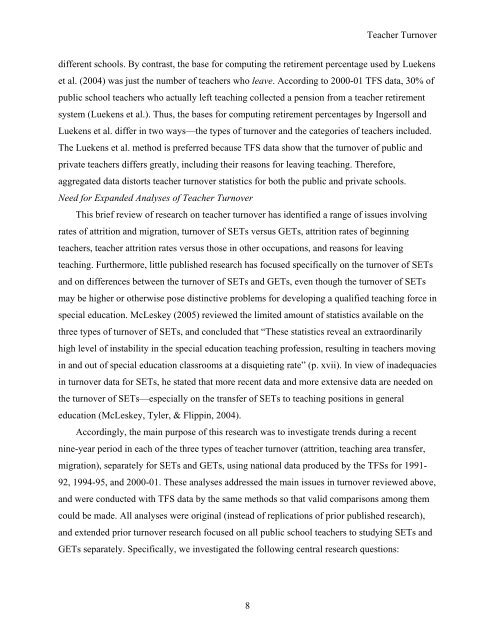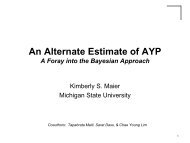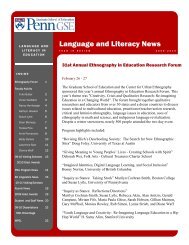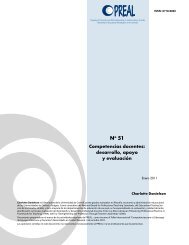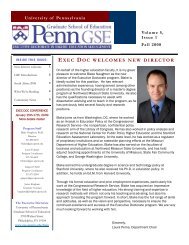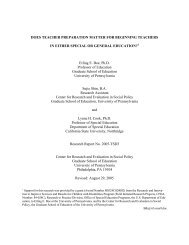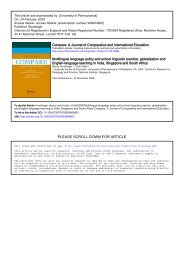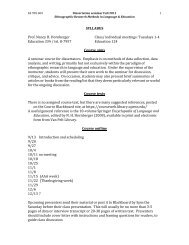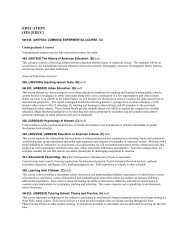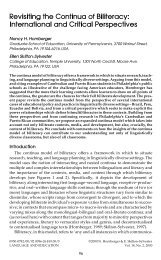Teacher turnover in special and general education: attrition
Teacher turnover in special and general education: attrition
Teacher turnover in special and general education: attrition
Create successful ePaper yourself
Turn your PDF publications into a flip-book with our unique Google optimized e-Paper software.
<strong>Teacher</strong> Turnover<br />
different schools. By contrast, the base for comput<strong>in</strong>g the retirement percentage used by Luekens<br />
et al. (2004) was just the number of teachers who leave. Accord<strong>in</strong>g to 2000-01 TFS data, 30% of<br />
public school teachers who actually left teach<strong>in</strong>g collected a pension from a teacher retirement<br />
system (Luekens et al.). Thus, the bases for comput<strong>in</strong>g retirement percentages by Ingersoll <strong>and</strong><br />
Luekens et al. differ <strong>in</strong> two ways—the types of <strong>turnover</strong> <strong>and</strong> the categories of teachers <strong>in</strong>cluded.<br />
The Luekens et al. method is preferred because TFS data show that the <strong>turnover</strong> of public <strong>and</strong><br />
private teachers differs greatly, <strong>in</strong>clud<strong>in</strong>g their reasons for leav<strong>in</strong>g teach<strong>in</strong>g. Therefore,<br />
aggregated data distorts teacher <strong>turnover</strong> statistics for both the public <strong>and</strong> private schools.<br />
Need for Exp<strong>and</strong>ed Analyses of <strong>Teacher</strong> Turnover<br />
This brief review of research on teacher <strong>turnover</strong> has identified a range of issues <strong>in</strong>volv<strong>in</strong>g<br />
rates of <strong>attrition</strong> <strong>and</strong> migration, <strong>turnover</strong> of SETs versus GETs, <strong>attrition</strong> rates of beg<strong>in</strong>n<strong>in</strong>g<br />
teachers, teacher <strong>attrition</strong> rates versus those <strong>in</strong> other occupations, <strong>and</strong> reasons for leav<strong>in</strong>g<br />
teach<strong>in</strong>g. Furthermore, little published research has focused specifically on the <strong>turnover</strong> of SETs<br />
<strong>and</strong> on differences between the <strong>turnover</strong> of SETs <strong>and</strong> GETs, even though the <strong>turnover</strong> of SETs<br />
may be higher or otherwise pose dist<strong>in</strong>ctive problems for develop<strong>in</strong>g a qualified teach<strong>in</strong>g force <strong>in</strong><br />
<strong>special</strong> <strong>education</strong>. McLeskey (2005) reviewed the limited amount of statistics available on the<br />
three types of <strong>turnover</strong> of SETs, <strong>and</strong> concluded that “These statistics reveal an extraord<strong>in</strong>arily<br />
high level of <strong>in</strong>stability <strong>in</strong> the <strong>special</strong> <strong>education</strong> teach<strong>in</strong>g profession, result<strong>in</strong>g <strong>in</strong> teachers mov<strong>in</strong>g<br />
<strong>in</strong> <strong>and</strong> out of <strong>special</strong> <strong>education</strong> classrooms at a disquiet<strong>in</strong>g rate” (p. xvii). In view of <strong>in</strong>adequacies<br />
<strong>in</strong> <strong>turnover</strong> data for SETs, he stated that more recent data <strong>and</strong> more extensive data are needed on<br />
the <strong>turnover</strong> of SETs—e<strong>special</strong>ly on the transfer of SETs to teach<strong>in</strong>g positions <strong>in</strong> <strong>general</strong><br />
<strong>education</strong> (McLeskey, Tyler, & Flipp<strong>in</strong>, 2004).<br />
Accord<strong>in</strong>gly, the ma<strong>in</strong> purpose of this research was to <strong>in</strong>vestigate trends dur<strong>in</strong>g a recent<br />
n<strong>in</strong>e-year period <strong>in</strong> each of the three types of teacher <strong>turnover</strong> (<strong>attrition</strong>, teach<strong>in</strong>g area transfer,<br />
migration), separately for SETs <strong>and</strong> GETs, us<strong>in</strong>g national data produced by the TFSs for 1991-<br />
92, 1994-95, <strong>and</strong> 2000-01. These analyses addressed the ma<strong>in</strong> issues <strong>in</strong> <strong>turnover</strong> reviewed above,<br />
<strong>and</strong> were conducted with TFS data by the same methods so that valid comparisons among them<br />
could be made. All analyses were orig<strong>in</strong>al (<strong>in</strong>stead of replications of prior published research),<br />
<strong>and</strong> extended prior <strong>turnover</strong> research focused on all public school teachers to study<strong>in</strong>g SETs <strong>and</strong><br />
GETs separately. Specifically, we <strong>in</strong>vestigated the follow<strong>in</strong>g central research questions:<br />
8


